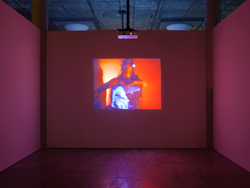Gallery Talk by EAI Executive Director Lori Zippay
Dia Art Foundation presents a Gallery Talk by EAI Executive Director Lori Zippay on the exhibition Circa 1971: Early Video & Film from the EAI Archive at Dia:Beacon, Riggio Galleries.

Photo: Bill Jacobson, New York.
Saturday, February 11, 2012
2 pm
Dia:Beacon
Riggio Galleries
3 Beekman Street
Beacon, NY 12508
www.diaart.org/circa1971
www.eai.org
Free with admission.
Space is limited. To make a reservation, please click here.
General Admission: $10
Students/Seniors: $7
Free for EAI & Dia Members
Become a Friends of EAI Member and receive free admission to Dia:Beacon on February 11th and 12th:
www.eai.org/eai/membership.htm
Lori Zippay, Executive Director of EAI and guest curator of Circa 1971: Early Video & Film from the EAI Archive, will present a Gallery Talk on the exhibition at Dia:Beacon on Saturday, February 11th. Organized on the occasion of EAI's 40th anniversary, Circa 1971 brings together more than 20 single-channel works from one of the world's most comprehensive collections of video art. Taking the year of EAI's founding as a point of departure, the exhibition sets in dialogue a series of diverse works linked by alternative artistic practices and activist impulses. Circa 1971 presents a snapshot of a cultural moment—or, more accurately, a countercultural moment—and the fertile political and artistic landscape from which these works emerged.
Circa 1971 includes pieces by Vito Acconci, Eleanor Antin, Ant Farm, John Baldessari, Lynda Benglis, Shirley Clarke, Dan Graham, Nancy Holt and Robert Smithson, Joan Jonas, Gordon Matta-Clark, Nam June Paik, Raindance, Anthony Ramos, Carolee Schneemann, TVTV, and Steina and Woody Vasulka, among others.
As much as the works in the exhibition reflect the prevailing discourses of contemporary art at the time—including body art, performance, Process art, Minimalism, and Conceptual art—they also directly respond to the pervasive cultural influence of television and the radical political and social movements of the late 1960s and early 1970s. Artists and activists were drawn to the conceptual, formal, and cultural implications of emergent video technology, as articulated in performances for the camera, guerrilla television documentaries, electronic imaging experiments, and interrogations of the metaphorical potential of the medium.
Many of the generative ideas and themes introduced in their nascent form in Circa 1971 have been reactivated by subsequent generations of artists and refracted through digital culture in current moving-image art. This 40th anniversary exhibition offers a framework for reconsidering the multiple histories, artistic investigations, and cultural contexts that have informed moving-image art for more than four decades.
__________________________________
Dia Art Foundation
A nonprofit institution founded in 1974, Dia Art Foundation is renowned for initiating, supporting, presenting, and preserving art projects. Dia:Beacon, Riggio Galleries, opened in May 2003 in Beacon, New York, on the banks of the Hudson River as the home for Dia's distinguished collection of art from the 1960s to the present. The museum, which occupies a former Nabisco printing factory, features major installations of works by a focused group of some of the most significant artists of the last half century, as well as special exhibitions, new commissions, and diverse public and education programs. Dia:Chelsea is located on West 22nd Street in the heart of New York City's gallery district, which it helped to pioneer. Currently open for artist lectures and readings, Dia is developing plans to expand its presence in Chelsea.
Dia also maintains long-term, site-specific projects. These include Walter De Maria's The New York Earth Room (1977) and The Broken Kilometer (1979), Max Neuhaus's Times Square (1977), Joseph Beuys's 7000 Eichen (7000 Oaks) (1988), and Dan Flavin's untitled (1996), in Manhattan; The Dan Flavin Art Institute, in Bridgehampton, New York; De Maria's Vertical Earth Kilometer (1977), in Kassel, Germany; Robert Smithson's Spiral Jetty (1970), in the Great Salt Lake, Utah; and De Maria's The Lightning Field (1977), in Quemado, New Mexico. For additional public information, visit www.diaart.org.
__________________________________
About EAI
Founded in 1971, Electronic Arts Intermix (EAI) is one of the world's leading nonprofit resources for video art. A pioneering advocate for media art and artists, EAI fosters the creation, exhibition, distribution, and preservation of video art and digital art. EAI's core program is the distribution and preservation of a major collection of over 3,500 new and historical media works by artists. EAI's activities include viewing access, educational services, extensive online resources, and public programs such as artists' talks, exhibitions and panels. The Online Catalogue is a comprehensive resource on the artists and works in the EAI collection, and also features extensive materials on exhibiting, collecting and preserving media art:
www.eai.org
Electronic Arts Intermix 535 West 22nd Street, 5th Floor New York, NY 10011
info@eai.org t (212) 337-0680 f (212) 337-0679
___________________________________
For additional information contact:
Holly Stanton, Electronic Arts Intermix: hstanton@eai.org
image: Nam June Paik and Jud Yalkut, with Charlotte Moorman, TV Cello Premiere, 1971. 16 mm film transferred to video (color, silent); 7:25 min. Circa 1971: Early Video & Film from the EAI Archive, Dia:Beacon, Riggio Galleries, Beacon, New York. Collection Electronic Arts Intermix, New York. September 17, 2011—September 4, 2012. Photo: Bill Jacobson, New York.
EAI on Facebook
EAI on Twitter
Dia on Facebook
Dia on Twitter